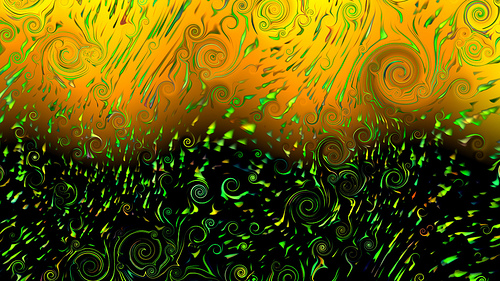 Evolution
Evolution
Problem 2: Unguided Chemical Processes Cannot Explain the Origin of the Genetic Code

Editor’s note: This is Part 2 of a 10-part series based upon Casey Luskin’s chapter, “The Top Ten Scientific Problems with Biological and Chemical Evolution,” in the volume More than Myth, edited by Paul Brown and Robert Stackpole (Chartwell Press, 2014). The full chapter can be found online here. Other individual installments can be found here: Problem 1, Problem 2, Problem 4, Problem 5, Problem 6, Problem 7, Problem 8, Problem 9, Problem 10.
Let’s assume that a primordial sea filled with life’s building blocks did exist on the early Earth, and somehow it formed proteins and other complex organic molecules. Theorists believe that the next step in the origin of life is that — entirely by chance — more and more complex molecules formed until some began to self-replicate. From there, they believe Darwinian natural selection took over, favoring those molecules that were better able to make copies of themselves. Eventually, they assume, it was inevitable that these molecules would evolve complex machinery — like that used in today’s genetic code — to survive and reproduce.
Have modern origin-of-life theorists explained how this crucial bridge from inert nonliving chemicals to self-replicating molecular systems took place? The most prominent hypothesis for the origin of the first life is called the “RNA world.” In living cells, genetic information is carried by DNA, and most cellular functions are carried out by proteins. However, RNA is capable of both carrying genetic information and catalyzing some biochemical reactions. As a result, some theorists postulate the first life might have used RNA alone to fulfill all these functions.
But there are many problems with this hypothesis.
For one, the first RNA molecules would have to arise by unguided, non-biological chemical processes. But RNA is not known to assemble without the help of a skilled laboratory chemist intelligently guiding the process. New York University chemist Robert Shapiro critiqued the efforts of those who tried to make RNA in the lab, stating: “The flaw is in the logic — that this experimental control by researchers in a modern laboratory could have been available on the early Earth.”15
Second, while RNA has been shown to perform many roles in the cell, there is no evidence that it could perform all the necessary cellular functions currently carried out by proteins.16
Third, the RNA world hypothesis does not explain the origin of genetic information.
RNA world advocates suggest that if the first self-replicating life was based upon RNA, it would have required a molecule between 200 and 300 nucleotides in length.17 However, there are no known chemical or physical laws that dictate the order of those nucleotides.18 To explain the ordering of nucleotides in the first self-replicating RNA molecule, materialists must rely on sheer chance. But the odds of specifying, say, 250 nucleotides in an RNA molecule by chance is about 1 in 10150 — below the universal probability boundary, or events which are remotely possible to occur within the history of the universe.19 Shapiro puts the problem this way:
The sudden appearance of a large self-copying molecule such as RNA was exceedingly improbable. … [The probability] is so vanishingly small that its happening even once anywhere in the visible universe would count as a piece of exceptional good luck.20
Fourth — and most fundamentally — the RNA world hypothesis does not explain the origin of the genetic code itself. In order to evolve into the DNA / protein-based life that exists today, the RNA world would need to evolve the ability to convert genetic information into proteins. However, this process of transcription and translation requires a large suite of proteins and molecular machines — which themselves are encoded by genetic information. This poses a chicken-and-egg problem, where essential enzymes and molecular machines are needed to perform the very task that constructs them.
The Chicken and the DVD
To appreciate this problem, consider the origin of the first DVD and DVD player. DVDs are rich in information, but without the machinery of a DVD player to read the disk, process its information, and convert it into a picture and sound, the disk would be useless. But what if the instructions for building the first DVD player were only found encoded on a DVD? You could never play the DVD to learn how to build a DVD player. So how did the first disk and DVD player system arise? The answer is obvious: a goal directed process — intelligent design — is required to produce both the player and the disk at the same time.
In living cells, information-carrying molecules (e.g. DNA or RNA) are like the DVD, and the cellular machinery which reads that information and converts it into proteins are like the DVD player. Just like the DVD analogy, genetic information can never be converted into proteins without the proper machinery. Yet in cells, the machines required for processing the genetic information in RNA or DNA are encoded by those same genetic molecules — they perform and direct the very task that builds them.
This system cannot exist unless both the genetic information and transcription / translation machinery are present at the same time, and unless both speak the same language. Biologist Frank Salisbury explained this problem in a paper in American Biology Teacher not long after the workings of the genetic code were first uncovered:
It’s nice to talk about replicating DNA molecules arising in a soupy sea, but in modern cells this replication requires the presence of suitable enzymes. … [T]he link between DNA and the enzyme is a highly complex one, involving RNA and an enzyme for its synthesis on a DNA template; ribosomes; enzymes to activate the amino acids; and transfer-RNA molecules. … How, in the absence of the final enzyme, could selection act upon DNA and all the mechanisms for replicating it? It’s as though everything must happen at once: the entire system must come into being as one unit, or it is worthless. There may well be ways out of this dilemma, but I don’t see them at the moment.21
Despite decades of work, origin-of-life theorists are still at a loss to explain how this system arose. In 2007, Harvard chemist George Whitesides was given the Priestley Medal, the highest award of the American Chemical Society. During his acceptance speech, he offered this stark analysis, reprinted in the respected journal, Chemical and Engineering News:
The Origin of Life. This problem is one of the big ones in science. It begins to place life, and us, in the universe. Most chemists believe, as do I, that life emerged spontaneously from mixtures of molecules in the prebiotic Earth. How? I have no idea.22
Similarly, the aforementioned article in Cell Biology International concludes: “New approaches to investigating the origin of the genetic code are required. The constraints of historical science are such that the origin of life may never be understood.”23 That is, they may never be understood unless scientists are willing to consider goal-directed scientific explanations like intelligent design.
But there is a much deeper problem with theories of chemical evolution, as well as biological evolution. This pertains not just to the ability to process genetic information via a genetic code, but the origin of that information itself.
References
[15.] Richard Van Noorden, “RNA world easier to make,” Nature news (May 13, 2009), http://www.nature.com/news/2009/090513/full/news.2009.471.html
[16.] See Stephen C. Meyer, Signature in the Cell: DNA and the Evidence for Intelligent Design, p. 304 (New York: HarperOne, 2009).
[17.] Jack W. Szostak, David P. Bartel, and P. Luigi Luisi, “Synthesizing Life,” Nature, 409: 387-390 (January 18, 2001).
[18.] Michael Polanyi, “Life’s Irreducible Structure,” Science, 160 (3834): 1308-1312 (June 21, 1968).
[19.] See William A. Dembski, The Design Inference: Eliminating Chance through Small Probabilities (Cambridge University Press, 1998).
[20.] Robert Shapiro, “A Simpler Origin for Life,” Scientific American, pp. 46-53 (June, 2007).
[21.] Frank B. Salisbury, “Doubts about the Modern Synthetic Theory of Evolution,” American Biology Teacher, 33: 335-338 (September, 1971).
[22.] George M. Whitesides, “Revolutions In Chemistry: Priestley Medalist George M. Whitesides’ Address,” Chemical and Engineering News, 85: 12-17 (March 26, 2007).
[23.] J.T. Trevors and D.L. Abel, “Chance and necessity do not explain the origin of life,” Cell Biology International, 28: 729-739 (2004).

